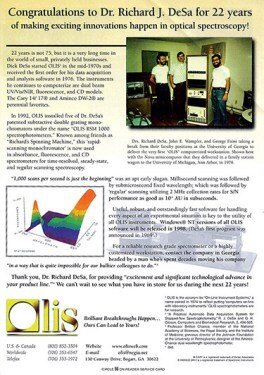The Ultimate Guide To Spectrophotometers
What Does Spectrophotometers Mean?
Table of ContentsLittle Known Facts About Uv/vis/nir.Little Known Questions About Uv/vis/nir.Unknown Facts About Circularly Polarized LuminescenceThe Greatest Guide To Circularly Polarized LuminescenceAll About Uv/vis

Spectrophotometry is most frequently used to ultraviolet, visible, and infrared radiation, modern spectrophotometers can interrogate large swaths of the electro-magnetic spectrum, consisting of x-ray, ultraviolet, noticeable, infrared, and/or microwave wavelengths. Spectrophotometry is a tool that depends upon the quantitative analysis of particles depending on just how much light is taken in by colored substances.
A Biased View of Circular Dichroism
A spectrophotometer is typically used for the measurement of transmittance or reflectance of services, transparent or opaque solids, such as sleek glass, or gases. Although lots of biochemicals are colored, as in, they soak up noticeable light and therefore can be measured by colorimetric procedures, even colorless biochemicals can frequently be transformed to colored substances appropriate for chromogenic color-forming responses to yield substances ideal for colorimetric analysis.: 65 Nevertheless, they can also be created to measure the diffusivity on any of the listed light varieties that normally cover around 2002500 nm utilizing various controls and calibrations.
An example of an experiment in which spectrophotometry is used is the decision of the balance constant of a service. A certain chemical response within an option might happen in a forward and reverse instructions, where reactants form products and items break down into reactants. Eventually, this chain reaction will reach a point of balance called a balance point.
The Uv/vis Statements
The quantity of light that goes through the option is indicative of the concentration of certain chemicals that do not enable light to travel through. The absorption of light is due to the interaction of light with the electronic and vibrational modes of molecules. Each kind of particle has a private set of energy levels related to the makeup of its chemical bonds and nuclei and hence will absorb light of particular wavelengths, or energies, leading to distinct spectral homes.
They are extensively used in many industries including semiconductors, laser and optical production, printing and forensic evaluation, as well as in labs for the study of chemical compounds. Spectrophotometry is typically used in measurements of enzyme activities, decisions of protein concentrations, determinations of enzymatic kinetic constants, and measurements of ligand binding reactions.: 65 Eventually, a spectrophotometer is able to determine, depending on the control or calibration, what substances are present in a target and exactly how much through computations of observed wavelengths.
Developed by Arnold O. Beckman in 1940 [], the spectrophotometer was created with the aid of his associates at his company National Technical Laboratories founded in 1935 which would become Beckman Instrument Company and eventually Beckman Coulter. This would come as an option to the formerly developed spectrophotometers which were not able to soak up the ultraviolet properly.
Uv/vis/nir Fundamentals Explained
It would be discovered that this did not offer satisfying results, for that reason in Design B, there was a shift from a glass to a quartz prism which permitted much better absorbance results - spectrophotometers (https://www.slideshare.net/julieanndesalorenz30). From there, Model C was born with a modification to the wavelength resolution which ended up having 3 systems of it produced
It was produced from 1941 to 1976 where the rate for it in 1941 was US$723 (far-UV accessories were an option at additional cost). In the words of Nobel chemistry laureate Bruce Merrifield, it was "probably the most important instrument ever developed towards the development of bioscience." Once it ended up being ceased in 1976, Hewlett-Packard created the first commercially readily available diode-array spectrophotometer in 1979 called the HP 8450A. It irradiates the sample with polychromatic light which the sample soaks up depending on its homes. It is transferred back by grating the photodiode variety which spots browse around this web-site the wavelength region of the spectrum. Ever since, the production and application of spectrophotometry gadgets has actually increased immensely and has turned into one of the most ingenious instruments of our time.

The Best Strategy To Use For Uv/vis
The grating can either be movable or repaired.
In such systems, the grating is fixed and the strength of each wavelength of light is measured by a various detector in the range. When making transmission measurements, the spectrophotometer quantitatively compares the portion of light that passes through a reference service and a test solution, then electronically compares the strengths of the two signals and calculates the portion of transmission of the sample compared to the referral requirement.
